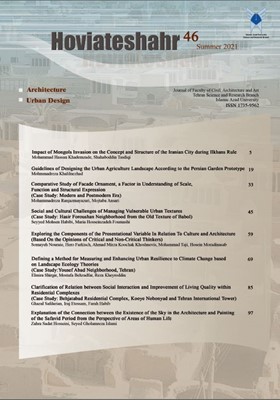ملاحظات برنامهریزی، ویژگیهای فضایی و اصول طراحی منظر کشاورزی شهری مطابق با الگوی باغ ایرانی
الموضوعات : architecture
1 - بیرجند- استادیار دانشگاه بیرجند- دانشکده هنر
الکلمات المفتاحية: باغ ایرانی, کشاورزی شهری, اصول طراحی, معماری منظر,
ملخص المقالة :
این مطالعه در پاسخ به این پرسش است که چه ویژگیهای فضایی در باغ ایرانی میتواند اصول طراحی منظر کشاورزی را معرفی نماید. هدف، بررسی اصول ادغام منظر کشاورزی و منظر زینتی در باغ ایرانی و معرفی اصول تلفیق عناصر گیاهی مثمر و زینتی در ساختار فضاهای سبز تاریخی است. این مطالعه با روش پژوهش در طراحی و مورد پژوهی با انجام مطالعات میدانی در هفت باغ تاریخی واقع در سه استان مختلف به انجام رسیده است. جنبههای سختافزاری سازماندهی فضایی و چیدمان فیزیکی- بصری عناصر مولد و زینتی در باغ ایرانی بهگونهای است که بر اساس آن میتوان چهاراصل مهم را بهعنوان قواعد معماری منظر مثمر معرفی نمود. اصل تفکیک فیزیکی بر جدایی فضای تولیدی از محورهای تفرجی تأکید دارد. اصل دوم، ترکیب بصری دو نوع نظام گیاهی در نگاه ناظر را مهم میشمارد. اصل سوم بر تداوم کاربرد دو اصل قبلی در کل فضای منظر و اصل مدیریت دسترسی گویای استراتژی محدودیت دسترسی به محصولات خوراکی منظر است.
اخوان، شمیم؛ و معقولی، نادیا (1399). مطالعۀ اثربخشی الگوهای ذهنی حاکمان تیموری بر باغ سازی تیموری با رویکرد تاریخ فرهنگی (نمونه موردی: باغهای نو، شمال و میدان در سمرقند). باغ نظر (17)83، 31-40.
پایگاه باغهای تاریخی خراسان جنوبی. (1398). آرشیو اسناد و نقشهها. بیرجند: منتشرنشده.
فرزین، سامان؛ خلیلنژاد، سید محمدرضا؛ مراد زاده، سعیده؛ و زارعی، علی (1399). بررسی ویژگیهای منظر چند عملکردی در باغ ایرانی (مطالعه موردی: میراث جهانی باغ اکبریه). منظر (12)52، 6-17.
کمپفر، انگلبرت (1360). سفرنامه انگلبرت. (کیکاوس جهانداری، مترجم). تهران: خوارزمی (نشر اثر اصلی 1727).
Bryant, C., Diaz, J. P., Keratia, B., Lohrberg, F. & Yokohari, M. (2016). Urban agriculture from a global perspective in Lohrberg F., Licka, L., Scazzosi, L. & Timpe, A. (Eds.), Urban Agriculture Europe. Berlin: Jovis.
Clark, K. H., & Nicholas, K. A. (2013). Introducing urban food forestry: A multifunctional approach to increase food security and provide ecosystem services. Landscape Ecology, 28(9), 1649–1669.
Clavijo, R. G. & Strange, G. L. (1928). Embassy to Tamerlane 1403-1406. London: Routledge.
Colinas, J., Bush, P., & Manaugh, K. (2019). The socio-environmental impacts of public urban fruit trees: A Montreal case-study. Urban Forestry and Urban Greening, 45, 2-17.
Della Valle, P. (1658). Viaggi di Pietro della Valle Il Pellegrino Descritti da lui medesimo in Lettere Familiari all’Erudito suo Amico Mario Schipano Divisi in Tre Parti cioè: La Turchia, la Persia e l’India colla Vita e Ritratto dell’Autore. Brighton: Gancia.
Gharipour, M. (2011). Transferring and Transforming the Boundaries of Pleasure: Multifunctionality of Gardens in Medieval Persia. Garden History, 39(2), 249-262.
Gharipour, M. (2013). Persian gardens and pavilions: reflections in history, poetry, and the arts. London and New York: I.B. Tauris.
Gmelin, S. G. (2015). Travels through Northern Persia: 1770-1774. (Willem Floor, Translator). Washington, DC: Mage Publishers.
Golombek, L. (1994). The Gardens of Timur: New Perspectives. Muqarnas Online, 12(1), 137–47.
Gori, A., Ferrini, F., & Fini, A. (2019). Growing healthy food under heavy metal pollution load : Overview and major challenges of tree based edible landscapes. Urban Forestry & Urban Greening, 45, 0–1.
Hou, J., & Grohmann, D. (2018). Integrating community gardens into urban parks: Lessons in planning, design and partnership from Seattle. Urban Forestry & Urban Greening, 33, 46–55.
Hale, J., Knapp, C., Bardwell, L., Buchenau, M., Marshall, J., Sancar, F., & Litt, J. S. (2011). Connecting food environments and health through the relational nature of aesthetics: Gaining insight through the community gardening experience. Social Science & Medicine, 72(11), 1853–1863.
Heimlich, J., Sydnor, T. D., Bumgardner, M., & O’Brien, P. (2008). Attitudes of residents toward street trees on four streets in Toledo, Ohio, U.S. before removal of ash trees (Fraxinus spp.) from Emerald ash borer (Agrilus planipennis). Arboriculture and Urban Forestry, 34(1), 47–53.
Herbert, T. (1634). A Relation of Some Yeares Travaile Begunne Anon 1626. Into Afrique and the greater Asia, especially the Territories of the Persian Monarchie: and some parts of the Orientall Indies, and Iles adiacent. London: William Stansby & Jacob Bloome.
Khalilnezhad, M. R. (2016). Urban agriculture as a tool for city and landscape planning in Iran with emphasis on the role of Persian gardens. Technical University of Kaiserslautern, Kaiserslautern.
Lafontaine-Messier, M., Gélinasb, N., & Olivier, A. (2016). Profitability of food trees planted in urban public green areas. Urban Forestry & Urban Greening, 16, 197–207.
Morckel, V. (2015). Community gardens or vacant lots? Rethinking the attractiveness and seasonality of green land uses in distressed neighborhoods. Urban Forestry & Urban Greening, 14(3), 714–721.
Napawan, N. C. (2014). Production Places: Evaluating Communally- Managed Urban Farms as Public Space. Landscape Journal, 34(1), 37-56.
Raupp, M. J., Cumming, A. B., & Raupp, E. C. (2006). Street tree diversity in eastern North America and its potential for tree loss to exotic borers. Arboriculture and Urban Forestry, 32(6), 297–304.
Ruggles, D. Fairchild. (2008). Islamic Gardens and Landscapes. Pennsylvania: University of Pennsylvania Press.
Teuber, S., Schmidt, K., Kühn, P., & Scholten, T. (2019). Engaging with urban green spaces – a comparison of urban and rural allotment gardens in Southwestern Germany. Urban Forestry & Urban Greening, 43, 235-250.
Shandiz, M. & Jacobs, P. (2005). Analyse du Jardin Royal de Fin en Perse (fin XVIe—XVIIe) d'aprés les source historiques. Studies in the History of Gardens & Designed Landscapes, 25(4), 273-296.
Shandiz, M. H. (2012). Retour aux sources pour une meilleure reconnaissance et valorisation du patrimoine paysager perse. Studies in the History of Gardens & Designed Landscapes, 32(3), 164-181.
Swaffield, S. (2017). Case studies in Brink, A., Bruns, D., Tobi, H., & Bell, S. (Eds). Research in Landscape Architecture Methods and methodology (pp. 188-211). London and New York: Routledge.
Yin, R.K. (2014). Case Study Research: Design and Methods. (5th ed.). Thousand Oaks, CA: Sage.
_||_

